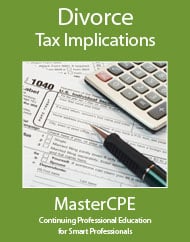Course Information
Divorce – Tax Implications
Course Information
| Title: | Divorce – Tax Implications |
|---|---|
| Category: | Taxation |
| Field of Study: | Taxes |
| Course Code: | M273 |
| CPE Credits: | 14.0 |
| Price: | 89.95 |
Description
Description:
This course will teach participants how to apply, implement, and evaluate the strategic tax aspects of marital dissolutions and living together arrangements. Current perspectives on property transfers, asset divisions, alimony, filing status, exemptions, and child support are examined with an emphasis on planning considerations. Property settlements, basis allocation, third party transfers, and purchases between spouses are explored and analyzed. Special attention is given to the division of business interests, retirement plans (including QDROs), insurance policies, and the family residence.
Delivery Method: Online Interactive Self Study
Level: Overview
Prerequisites: None
Advanced Preparation: None
Course Details
Category: Taxation
Field of Study: Taxes
Passing Score: 70%
Technical Details: Taxation is a technical field of study for all states.
For More Detail:
If you are unable to view PDF then right click the mouse and click save link as
Objectives
Objectives:
Chapter 1: Basic Marital Tax Matters 1. Specify multiple tax implications to consider when going through a divorce, and recognize the requirements and effects of filing as married or unmarried. 2. Identify the requirements for filing a joint return and how to avoid being penalized. 3. Determine the key elements of filing separate returns including what items to report and identify whether or not married taxpayers should file separate returns. 4. Cite the requirements for filing as head of household and the tax advantages and disadvantages of this filing status. 5. Recognize the repeal of personal exemptions, their pre-2018 phase-out, availability, and reporting requirements. 6. Identify the requirements for pre-2005 dependency particularly relationship, married person, citizen or resident and income, and specify the former regular and special method for determining support recognizing complications from back child support. 7. Determine the current “qualified child” standard using residency, relationship, age,
For More Objectives:
If you are unable to view PDF then right click the mouse and click save link as
Profession
NASBA: Yes
QAS: Yes
CPA: Suitable for all CPAs
IRS: IRS credit for Enrolled Agents.
Profession Identifiers: CPA, EA

